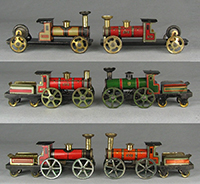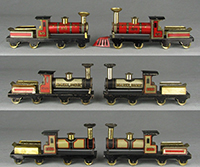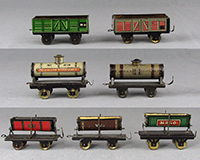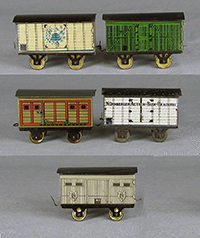 |
||||
|---|---|---|---|---|
 |
Hess 575 variations - 1 The 575 series locomotive has untold numbers of variations. Here are a few in my collection. Top left: Gray boiler, flywheel powered; Top right: Red boiler, flywheel powered; Second row left: Clockwork powered, red boiler, tinplate wheels; Second row right: Clockwork powered, green boiler, tinplate wheels; Third row left: Early graphics, clockwork powered, red boiler, cast wheels; Third row right: Later graphics, clockwork powered, red boiler, cast wheels. |
|||
 |
Hess 575 variations – 2 More variations of the 575 series locomotive. Over a period of approximately 40 years, this staple of the Hess factory was modified so many times. Variety is endless, but here are a few in my collection. Top left: Probably the most produced and seen locomotive when anyone thinks of the 575 series; Top right: Definitely made for the United States market, this loco had a cowcatcher added; Second row left: Gray boiler variation with red cab, paper litho on tender, marked with “575” and “Marke Sonne”, a Hess registered trademark; Second row right: Gray boiler variation with gray cab, paper litho on tender (missing) marked with “575” and “Marke Sonne”; Third row left: Gray boiler, paper litho on tender (missing), marked “575”; Third row right: Gray boiler, paper litho on tender reading “Made in Germany”, marked “575”. |
|||
 |
Hess 575 freight cars – 1 Over a period of 40 or so years, styles and graphics changed on different freight cars. Here are a few: Top row left: early open gondola marked with “M H” (Matthias Hess) and “120”; Top right: later production open gondola with no markings; Second row left: early petroleum tanker marked “No. 1040”; Second row right: later production petroleum tanker; Bottom row left: late production tipping gondola marked “575”; Bottom middle: mid production tipping gondola marked “No. 575”; Bottom right: early tipping gondola marked “50”. |
|||
 |
Hess 575 freight – 2 There are probably many other 575 freight cars that I have not observed, but here are a few in my collection. Top row left: early boxcar with beehive printed on sides; Top row right: early boxcar car in green; Middle row left: later production boxcar, unmarked; Middle row right: early production boxcar for beer; Bottom row: early boxcar with Hess logo on sides. |
|||
 |
Hess 575 Freight – 3 This car is decorated with a beer brewer’s symbol, consisting of the crossed mash crutch, malt shovel and beer scoop, indicating this wagon was used to transport beer. |
|||
 |
Hess 575 passenger car variations Over the lifetime of the 575 series, different graphics were printed on carriages. Left: Graphics printed by Hess for the Carette series 906 (Hess series 575), marked “G.C.& Co. N.” Middle: Early carriage marked “M H” (Matthias Hess); Right: Later production carriage graphics used until Hess ceased business in 1934. Very early carriages used a one piece wheelset, with wheels affixed by lead to the axle. Later, Hess developed a three piece wheelset which was used on most of these cars. Early carriages have been observed in yellow, blue and brown. Later produced carriages have been observed in yellow, blue and red. |
|||
 |
Hess 575 series different style wheels Wheels on the far right are a one piece wheelset, fastened to a completely round axle by lead and are the earliest used by Hess on the 575 series trains. Wheels on the far left are bright gold and not fastened to the axle but are kept in place by a flattened portion of the axle. Wheels in the middle are a bronze color and were used on the latest of the Hess 575 trains. All wheels are .5625” (22 mm); axles are 1.5625” (3.97 cm). |
|||
.jpg) |
Hess 575 Petroleum Tankers, circa 1900 - 1934 Over the lifetime of the Hess 575 series of trains, at least 3 different style petroleum tankers were produced. Image at top of photo is probably the oldest produced noted by earlier model thickness of frame. It is marked “1040” and “Petroleum Transport”. Tanker in the middle has no markings. Tanker at bottom is marked “JLH” and “No. 1”.
|
|||

